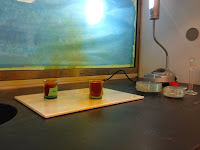This Tuesday, we had a test on Covalent bonding.
Overall, I felt better about this test than the last test on Stoichiometry. I haven't looked back at my test yet so I don't know what I got wrong.
Hydrogen Bonding
We also got introduced to hydrogen bonding this week. We read an article about the osmosis of paintballs and the reason behind it. It turns out that there are small attractions called hydrogen bonding between the hydrogen and the oxygen atoms because of the positive polarity on hydrogen and negative polarity on oxygen.
To help understand the material, we wrote an essay on a Paintball essay by Brian Rohrig called "Paintballs"
Ionic bonding
We started our next unit on ionic bonds. In an ionic bond, the electrons are freely moving within the material, unlike covalent bonds where they are sharing electrons. The ionic bond is between a Cation (positive) and an Anion (negative). In NaCl, the sodium ion is smaller than the chlorine atoms because it looses one row of electrons to the Cl.
To help understand this, we did a pogil on Ionic Bonding.
We also learned that those with an anion or cation with a higher charge has more force between their attraction. The smaller the ionic compound, the larger the melting point. Melting point depends on how much energy it takes to break or spread the bonds between the ions.
Metals
There is a lecture quiz due this Sunday on Metals.
Characteristics of metals include:
- conductivity
- malleable (able to be pressed into different shapes)
- ductile (able to be drawn into wire)
- metals aren't as brittle as other solids
They are not covalently bonded, but they have extremely strong bonds between the ions.
Electron-Sea Model is a representation of how electrons on the outermost valance swims around freely inside the sample. The rest of the ions are structured like this
This explains its conductivity.
Alloys are mixtures of elements that have property characteristics of metals. This can be a metal within a metal, or can be a non-metal within a metal (they are located in the staircase on the periodic table). Solution alloys are solutions such as Steel (Carbon and Iron). They can be substitutional alloys where solute particles take the place of the solvent metal atom, or an interstitial alloy where the solute particles are so small they can fit into the holes between the solvent metal ions. Therefore they are usually more dense than substitutional alloys.
Main Ideas
The main idea that was new this week was the introduction to ionic bonds and metals. I feel relatively comfortable with these ideas because a lot of this material has been gone over last year in SG Chem 1. The only think that I'm wondering about is what is the charge on these atoms measured in? (what is the unit of charge? Coulomb?)





